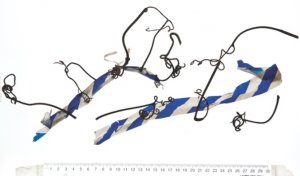Botrytis is an opportunistic disease, with spores hanging around until conditions are right before flaring into a major epidemic. NZ Wine’s fact sheet on the disease says to control botrytis, it requires an integrated approach involving vigour control, canopy management, fungicide application and a reduction in botrytis inoculum. Achieving that reduction means growers have to ensure all material potentially carrying botrytis spores is removed during the winter months. Up until recently, that has meant removing all dead wood after pruning, clearing rachi out of canes and removing tendrils. Research has shown the inoculum does survive on rachi, petioles and canes. But there has been no research determining if tendrils are also a source for over wintering spores.
Dion Mundy from Plant & Food at the Marlborough Research Centre said at a previous Grape Day, growers asked if there was any scientific reason to support the removal of tendrils. Not surprising when you consider the estimated labour cost of doing just that.
Removing tendrils from canes laid down is estimated to be between 10 and 15 cents per vine, which means the industry is paying anywhere from $2.5 million and $5 million per annum on this one task.
During the research project, dozens of tendrils were removed from previously botrytis infected vines in both Marlborough and Hawkes Bay. The two regions have differing levels of botrytis infection, with the spores known to be always present in the north, while in Marlborough the spores develop only in certain climatic conditions. In Marlborough’s case all the tendrils were taken from Sauvignon Blanc, whilst a range of varieties made up the Hawkes Bay research.
“They were placed onto flagging tapes and returned to a single vineyard in each region prior to the flowering sprays going on. Half of the samples were taken prior to pre flowering and the other half were collected after the pre bunch closure had gone on,”Mundy said.
The tendrils were incubated and then washed to dislodge any spores. The results were very different to those involving rachi.
The highest number of spores was 6000 per centimetre, which Mundy said may sound like a lot – but actually isn’t. He said in research trials they would inoculate an item with tens of thousand more spores, than those discovered on the tendrils.
“These were quite low spore numbers and by the second sampling (at pre bunch closure) they had been reduced greatly.”
In general the average number of spores per centimetre was higher for Hawkes Bay than Marlborough, which was consistent with other research undertaken. In terms of how the spore numbers compared to the research on rachi, Mundy said the tendrils produced quite a few less spores.
“And the spores we produced were incubated at optimum temperatures for seven days with high humidity. That was the maximum potential. We don’t expect you to ever experience those conditions out in the field. So in most situations, tendrils from a disease point of view could be left on. They are not really posing a big risk. And if you are spending a lot of money cutting them off and it’s affecting your profitability, I would recommend you don’t do it.”
But he did have a word of warning.
“If you are going to change any of your vineyard practises, either leave a small area where you do leave them, as a control, to see if it does make a difference to your final disease or vice versa. But our findings show that there is no need to have to cut those tendrils off to reduce disease risk.”
There are two key periods when Botrytis infections are likely to occur:
Flowering to bunch closure, when Botrytis infects senescing flower parts (such as flower caps and aborted berries); and
Veraison to harvest, when ripening berries become susceptible to infection. Botrytis infections are favoured by warm wet weather.
Disease pressure tends to be higher and more frequent in northern and western areas of the North Island, with lower pressure in eastern areas. Disease pressure is generally lower in the South Island, although Botrytis outbreaks may occur following warm rainfall at the key infection periods.
It has to be remembered that not all botrytis infections are a result of spores surviving over winter, Mundy said. They can also come in from other sources, such as a neighbour’s vineyard or other plants, given botrytis is not confined to grapes alone.
There are a multitude of options open to growers to help prevent an outbreak following fruit set.
These include shoot thinning, sprays, trash removal, leaf plucking, canopy exposure and even mechanical thinning.
In terms of preventing any spores hanging around the vineyard over winter, the advice is to remove cane prunings, either through mulching, burning or burial so they are no longer a source in the coming year. ν
This email address is being protected from spambots. You need JavaScript enabled to view it.










